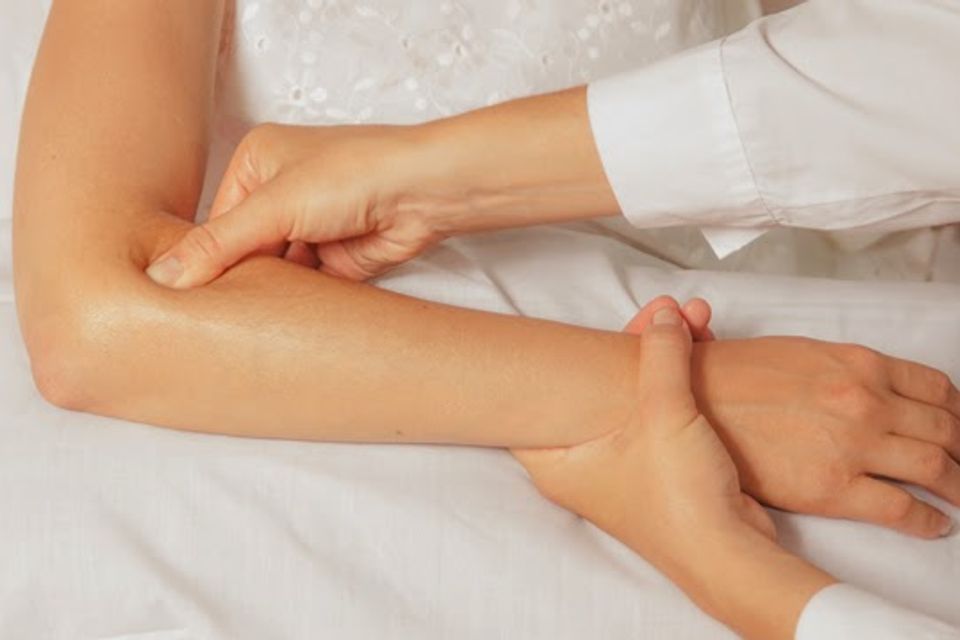
WHAT IS TRIGGER POINT THERAPY?
Trigger points are termed as hyper-irritable points in the muscle and fascial matrix, which can alter nervous system function. They are also often created by nervous system stress. Trigger points can be anywhere in the body, and can result from a local injury or from one distant from where the injury is perceived to be. They are described as hard nodules, tight bands of fiber, or “knots” in the muscle or fascia. Actually, many trigger points refer pain to a distant area – common examples are a trigger point in the calf muscle causing ankle or foot pain or a trigger point in the upper trapezius causing jaw or headache-type pain.
The concept behind trigger points is nothing new. In 1942, medical physician Dr. Janet Travell coined the term based upon what she described as myofascial pain syndromes. This basically means pain derived from muscle, fascia, or both. Fascia is the thick type of connective tissue that surrounds pretty much everything in your body, from muscles to blood vessels to organs.
In the 1960s, chiropractic physician Dr. George Goodheart used a similar type of trigger point therapy in his office to correct muscle imbalances. He called his therapy “origin-insertion technique” and observed that when manually treating a “knot” in the muscle or fascia that not only was the patient’s pain lessened or eliminated, but muscle strength, posture, and range of motion improved too. Stretching will not change a muscle that is neurologically facilitated (in spasm); exercise of any type will not benefit a muscle that is neurologically inhibited (weak) more than temporarily. Many hold onto this belief that either type of therapy provides healing benefits. Trigger point therapy, however, has the ability to correct these muscle imbalances and restore function, often very quickly.
How Do You Treat a Trigger Point?
Ideally when you treat a trigger point you’re pressing on it just hard enough but not too hard – you sorta have to get a feel for it. This can sometimes be difficult to do on yourself. You can hold a trigger point, or rub it in a circular motion (either direction), or work the trigger point in a back-and-forth direction. One method may provide a better result than another on a case-by-case basis. Apply pressure or rub out the trigger point for at least 10-15 seconds. If the pain is improving as you treat the point then continue until there is no further relief. Sometimes you can actually feel the trigger point “wash away” beneath your fingers and disappear.
One main benefit for treating a trigger point is that it helps correct neurological muscle imbalances. Other therapies such as acupuncture, chiropractic and cranial-sacral adjustments, nutritional and lifestyle interventions, and biofeedback programs can also correct muscle imbalances which is vital to injury prevention and treatment. As mentioned previously, stretching and exercise-therapies cannot correct muscle imbalances; they can only alter its function for a very short period (often less than one minute). Once the neurological muscle imbalances are corrected, then rehabilitation via exercise is definitely recommended. By addressing the trigger points as described, muscle fibers and connective tissue (including scar tissue) can re-align so they may begin to heal and the injured area may remove waste through improved blood flow. It is also suspected that it may help with inflammation, perhaps much like compressing an injury can be beneficial.
Why Do You Have Trigger Points? (Are You Addressing the Problem?)
The cause of the problem is often distant from where it is felt. This means that a problem in the thigh can be causing foot pain, or a problem in the foot may be causing a knee, low back, or even neck pain. This has a lot to do with the fascial connections throughout the body as well as our kinetic chain (how we move) – the foot affecting the knee – the knee affecting the hip – the hip affecting the back.
Remember, muscle imbalances can come from everything and anything – and most often these are a result of too much stress, (including exercise training), and a poor diet. I think this is a vital point because so many people, including “fit athletes” eat poorly, are under substantial stress, and train improperly. So what happens? Well, they get injured. Then they themselves, their doctor, or therapist looks only where the injury is felt. Although this is necessary to some degree depending on the injury, you have to address the WHY, more than the WHERE. Also, the longer the injury is present, or has gone unresolved, (such as the injury you perhaps had for months that just slowly went away on its own), the greater chance that you’ll have a lot of trigger points present that you don’t even realize. That old ankle injury can easily create shoulder problems, and most docs won’t even consider linking the two together.
Remember – trigger points can correct muscle imbalances and that’s how you can effectively treat an injury or prevent one from occurring. One area might respond to a trigger point whereas another area might not. If an area doesn’t respond it’s either because you’re on the wrong trigger point, you aren’t treating it correctly, (too much or too little pressure or time), or most often, that trigger point needs its source addressed – dietary, lifestyle, training, footwear change perhaps, or maybe a different therapy such as acupuncture, chiropractic, or another effective type of bodywork.
Call (513) 324-3211
The concept behind trigger points is nothing new. In 1942, medical physician Dr. Janet Travell coined the term based upon what she described as myofascial pain syndromes. This basically means pain derived from muscle, fascia, or both. Fascia is the thick type of connective tissue that surrounds pretty much everything in your body, from muscles to blood vessels to organs.
In the 1960s, chiropractic physician Dr. George Goodheart used a similar type of trigger point therapy in his office to correct muscle imbalances. He called his therapy “origin-insertion technique” and observed that when manually treating a “knot” in the muscle or fascia that not only was the patient’s pain lessened or eliminated, but muscle strength, posture, and range of motion improved too. Stretching will not change a muscle that is neurologically facilitated (in spasm); exercise of any type will not benefit a muscle that is neurologically inhibited (weak) more than temporarily. Many hold onto this belief that either type of therapy provides healing benefits. Trigger point therapy, however, has the ability to correct these muscle imbalances and restore function, often very quickly.
How Do You Treat a Trigger Point?
Ideally when you treat a trigger point you’re pressing on it just hard enough but not too hard – you sorta have to get a feel for it. This can sometimes be difficult to do on yourself. You can hold a trigger point, or rub it in a circular motion (either direction), or work the trigger point in a back-and-forth direction. One method may provide a better result than another on a case-by-case basis. Apply pressure or rub out the trigger point for at least 10-15 seconds. If the pain is improving as you treat the point then continue until there is no further relief. Sometimes you can actually feel the trigger point “wash away” beneath your fingers and disappear.
One main benefit for treating a trigger point is that it helps correct neurological muscle imbalances. Other therapies such as acupuncture, chiropractic and cranial-sacral adjustments, nutritional and lifestyle interventions, and biofeedback programs can also correct muscle imbalances which is vital to injury prevention and treatment. As mentioned previously, stretching and exercise-therapies cannot correct muscle imbalances; they can only alter its function for a very short period (often less than one minute). Once the neurological muscle imbalances are corrected, then rehabilitation via exercise is definitely recommended. By addressing the trigger points as described, muscle fibers and connective tissue (including scar tissue) can re-align so they may begin to heal and the injured area may remove waste through improved blood flow. It is also suspected that it may help with inflammation, perhaps much like compressing an injury can be beneficial.
Why Do You Have Trigger Points? (Are You Addressing the Problem?)
The cause of the problem is often distant from where it is felt. This means that a problem in the thigh can be causing foot pain, or a problem in the foot may be causing a knee, low back, or even neck pain. This has a lot to do with the fascial connections throughout the body as well as our kinetic chain (how we move) – the foot affecting the knee – the knee affecting the hip – the hip affecting the back.
Remember, muscle imbalances can come from everything and anything – and most often these are a result of too much stress, (including exercise training), and a poor diet. I think this is a vital point because so many people, including “fit athletes” eat poorly, are under substantial stress, and train improperly. So what happens? Well, they get injured. Then they themselves, their doctor, or therapist looks only where the injury is felt. Although this is necessary to some degree depending on the injury, you have to address the WHY, more than the WHERE. Also, the longer the injury is present, or has gone unresolved, (such as the injury you perhaps had for months that just slowly went away on its own), the greater chance that you’ll have a lot of trigger points present that you don’t even realize. That old ankle injury can easily create shoulder problems, and most docs won’t even consider linking the two together.
Remember – trigger points can correct muscle imbalances and that’s how you can effectively treat an injury or prevent one from occurring. One area might respond to a trigger point whereas another area might not. If an area doesn’t respond it’s either because you’re on the wrong trigger point, you aren’t treating it correctly, (too much or too little pressure or time), or most often, that trigger point needs its source addressed – dietary, lifestyle, training, footwear change perhaps, or maybe a different therapy such as acupuncture, chiropractic, or another effective type of bodywork.
Call (513) 324-3211
